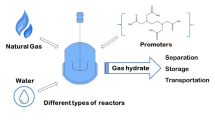Abstract
Gas hydrates are considered a nuisance in the flow assurance of oil and gas production since they can block the flowlines, consequently leading to significant losses in production. Hydrate avoidance has been the traditional approach, but recently, hydrate management is gaining acceptance because the practice of hydrate avoidance has become more and more challenging. For better management of hydrate formation, we investigated the risk of hydrate formation based on the subcooling range in which hydrates form by associating low, medium, and high probability of formation for a gas+oil+water system. The results are based on batch experiments which were performed in an autoclave cell using a mixture gas (CH4: C3H8=91.9 : 8.1 mol%), total liquid volume (200 ml), mineral oil, watercut (30%), and mixing speed (300 rpm). From the measurements of survival curves showing the minimum subcooling required before hydrate can form and hydrate conversion rates for the initial 20 minutes, we developed a risk map for hydrate formation.
Similar content being viewed by others
References
E. Dendy Sloan Jr and Carolyn Koh, Clathrate Hydrates of Natural Gases, 3rd Ed., CRC Press (2007).
E.G. Hammerschmidt, Ind. Eng. Chem., 26, 851 (1934).
E.D. Sloan, C. Koh and A.K. Sum, Natural Gas Hydrates in Flow Assurance, Elsevier, Amsterdam (2010).
P.D. Dholabhai, J. S. Parent and P.R. Bishnoi, Ind. Eng. Chem. Res., 35, 819 (1996).
A. H. Mohammadi, W. Afzal and D. Richon, J. Chem. Eng. Data, 53, 73 (2008).
A. Majumdar, E. Mahmoodaghdam and P.R. Bishnoi, J. Chem. Eng. Data, 45, 20 (2000).
W. Afzal, A. H. Mohammadi and D. Richon, J. Chem. Eng. Data, 53, 663 (2008).
W. Afzal, A. H. Mohammadi and D. Richon, J. Chem. Eng. Data, 52, 2053 (2007).
K. Shin, J. Kim, Y.-T. Seo and S.-P. Kang, Korean J. Chem. Eng., 31, 2177 (2014).
A. Vysniauskas and P.R. Bishnoi, Chem. Eng. Sci., 38, 1061 (1983).
P.R. Bishnoi, A.K. Gupta, P. Englezos and N. Kalogerakis, Fluid Phase Equilib., 53, 97 (1989).
P.R. Bishnoi and V. Natarajan, Fluid Phase Equilibr., 117, 168 (1996).
D. Lee, Y. Lee, S. Lee and Y. Seo, Korean J. Chem. Eng., 33, 1425 (2016).
E.D. Sloan, Fluid Phase Equilib., 228-229, 67 (2005).
K. Kinnari, J. Hundseid, X. Li and K. M. Askvik, J. Chem. Eng. Data, 60, 437 (2015).
E.O. Straume, C. Kakitani, D. Merino-Garcia, R.E.M. Morales and A. K. Sum, Chem. Eng. Sci., 155, 111 (2016).
N. Maeda, D. Wells, N. C. Becker, P. G. Hartley, P.W. Wilson, A.D. J. Haymet and K.A. Kozielski, Rev. Sci. Instrum., 82, 065109 (2011).
N. Maeda, D. Wells, P. G. Hartley and K.A. Kozielski, Energy Fuels, 26, 1820 (2012).
N. Maeda, Fluid Phase Equilib., 413, 142 (2016).
P.W. Wilson, A. F. Heneghan and A.D. J. Haymet, Cryobiology, 46, 88 (2003).
P.W. Wilson, D. Lester and A.D. J. Haymet, Chem. Eng. Sci., 60, 2937 (2005).
P. Linga, R. Kumar and P. Englezos, Chem. Eng. Sci., 62, 4268 (2007).
Author information
Authors and Affiliations
Corresponding authors
Additional information
This article is dedicated to Prof. Ki-Pung Yoo on the occasion of his retirement from Sogang University.
Electronic supplementary material
Rights and permissions
About this article
Cite this article
Kwak, GH., Lee, KH., Lee, B.R. et al. Quantification of the risk for hydrate formation during cool down in a dispersed oil-water system. Korean J. Chem. Eng. 34, 2043–2048 (2017). https://doi.org/10.1007/s11814-017-0112-3
Received:
Accepted:
Published:
Issue Date:
DOI: https://doi.org/10.1007/s11814-017-0112-3




